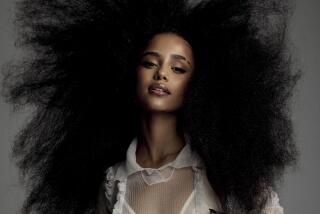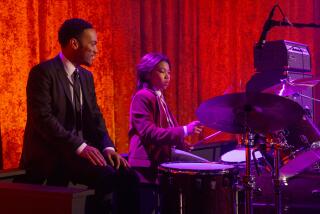Through ups and downs and forgotten girl groups, R&B singer Mila J is still standing tall
If attaining stardom is a mix of talent, image and pure luck, then singer Mila J should be in a better position than most.
Mila had her first brush with fame at the age of 9 when she appeared in Prince’s 1991 music video “Diamonds and Pearls.” In the 1990s and early 2000s, she performed with R&B girl groups before reinventing herself as a solo artist.
But while a breakout hit has eluded her, Mila hasn’t lost her determination. Last month she released a surprise five-track sultry and dreamy R&B EP named after her birthday, “11.18.”
That effort, released as a download-only and independently via Silent Partner Entertainment/November Reign, came after years of trying to issue a proper debut, a quest that dates back to the mid-2000s, when Universal Motown was once set to issue an album she said would be called “Split Personality.”
It wasn’t to be. And in the years since, Mila has seen her younger sister, Jhené Aiko, become one of the next big things in R&B.
Despite a career full of stops and starts, there isn’t any frustration evident in the 35-year-old. This despite working tirelessly in an industry that can be an uphill battle for women in hip-hop and R&B.
Everybody’s journey is just kind of different.
— Mila J
An L.A. native, Mila chose to discuss her ups and downs at a place that feels like home, Simply Wholesome, a South L.A. restaurant she frequented when growing up.
Sporting ankle-length black and green braids and emanating an aura of cool, heads turned when the singer stepped inside the restaurant. “I grew up literally behind here,” she said after catching up with some of the restaurant’s employees.
Born Jamila Chilombo, the singer’s South L.A. home was an artistic playground where her father, a pediatrician and musician, converted the family garage into a studio. Her mother was an art teacher who encouraged Mila and her siblings to explore their creativity.
After her older sister Miyoko began booking music videos, Mila quickly followed suit, catching the attention of record producer and manager Chris Stokes, who proposed they form a group that would eventually become Gyrl. With a sound heavily influenced by ’90s R&B staples like Aaliyah and TLC, Mila performed on national tours while only in middle school.
But the glamour was short-lived.
Although the group released several singles, Gyrl never completed an album, fading out just a few years after being formed. Shortly after, Mila J joined another Stokes-helmed girl group, Dame Four, and, in similar fashion, the group fizzled after a few singles.
For some, these events could have been career-ruining setbacks.
“I would say the first time our girls group only got to put out a single — we never put out an album — it was kind of devastating,” she said. “But now I know that could happen. Everybody’s journey is just kind of different.”
After disappointing girl group runs, she took a break from music, at one point working at a luxury day spa in L.A. She reemerged in 2006 as a solo artist. In 2012, she rechristened herself as Japollonia, then reverted to Mila J in 2014.
Today Mila has decided to take matters into her own hands as an independent artist by releasing music via a series of EPs.
When you’re an artist and creative, you think that’s all it’s going to be about, and that’s maybe 10% of it.
— Mila J
Decades of working in the industry reinforced to Mila that getting signed to a label is only the first step in “making it.”
“When you’re an artist and creative, you think that’s all it’s going to be about, and that’s maybe 10% of it,” she said. “I think learning how to deal with the business aspect of it is the part that’s draining.”
But for women artists, particularly black women, success in hip-hop and R&B comes with a unique set of challenges. Just take a look at the Billboard’s R&B and hip-hop singles chart. Of the top 50 songs, just two are women-fronted (the first coming in at No. 3 — rapper Cardi B’s “Bodak Yellow”).
“There are a lot of artists like her that have been around for a very long time and have varied levels of success but have not been able to break through,” said Cornell University hip-hop scholar Oneka LaBennett.
The success, however, of R&B artists doing it their own way — Solange, SZA, Kelela, even Mila’s younger sister, Aiko — shows the public is currently craving more variety and will support those who push boundaries.
“It’s super cool,” Mila said of her sister’s success. “For her to succeed living her dream, that’s dope.”
For now, Mila is staying focused on her craft, creating music that both feeds her soul and satisfies her fans.
“I can’t say what the moment will be for me, but I’m prepared to put out quality product,” she said. “I can’t necessarily call it.”
More to Read
The biggest entertainment stories
Get our big stories about Hollywood, film, television, music, arts, culture and more right in your inbox as soon as they publish.
You may occasionally receive promotional content from the Los Angeles Times.











